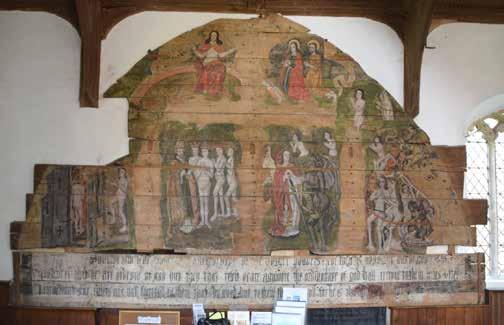
2 minute read
The Wenhaston Doom Simon Knott
from BookTalk 173
Wenhaston Doom
the wenhaston doom
Advertisement
BY SIMON KNOTT
[The three paintings by Edmund Stearne in Michelle Paver’s Wakenhyrst resembled the ‘Wakenhyrst Doom’ which he had discovered in the local parish church in 1911 and which is based on the real-life Wenhaston Doom found under whitewash in the 1890s. It is described here by Simon Knott author of the website www.suffolkchurches.co.uk/ ] England’s medieval churches contain many treasures which we would willingly travel down to London to see if they were in the Victoria and Albert Museum. But here they are, scattered across the land in ancient buildings sitting in villages and hamlets and among the fields. Among the most extraordinary survivals here in Suffolk is the Wenhaston Doom.
19
A Doom painting depicts the Last Judgement, the occasion on which some Christians believe Christ will return to judge humankind. This event, suggested at several points in the Bible, was understood by late medieval people to be a sorting of those souls who would enter Heaven, and those whose fate was to end up in Hell. In the years before the Reformation many churches put an often-lurid depiction of the Last Judgement above their chancel arch as a foil to the rood, a sculpture of the crucifixion. The Wenhaston Doom was painted on boards in the first decades of the 16th Century. Within forty years it had been whitewashed by the protestant reformers. In the mid-19th Century the boards were taken down by restorers and abandoned in the churchyard to be burnt. However, that night it rained, washing away the covering and revealing wonderful things. In vivid
Wenhaston Church colours, angels sound the last trump, and the dead rise from their graves. Christ sits on a rainbow, overseeing everything. His mother and St John the Baptist bring forward prayers for the souls of the dead. However, the real battle is between St Michael and the Devil, who have charge of the scales, and weigh each soul against its unreconciled sins. St Peter is seen receiving nobility. We can tell from their headgear that they include royalty, a bishop and a cardinal, but they are otherwise naked, to signify to the medieval faithful that all are equal before God. To the left, souls are received through a narrow gate into Heaven, while those on the right are marched off to Hell, dragged into its jaws by demons with chains. This fabulous art object is now on display in the north aisle of Wenhaston church, not far from Blythburgh. The church is open every day.








